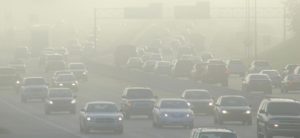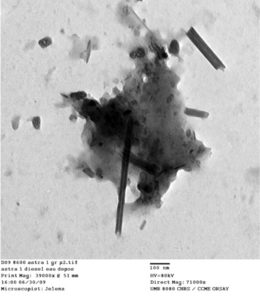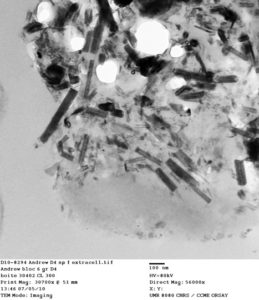 The use of nanomaterials has been really increasing in recent years without us really understanding if nanoparticles have negative health effects, and if they travel to the brain or other organs in the human body. Nanoparticles are used in many consumer products, including foods (e.g., nano-sized titanium dioxide) and medicines, but they are also found in air pollution (e.g., tires breaking down, vehicle exhaust).
The use of nanomaterials has been really increasing in recent years without us really understanding if nanoparticles have negative health effects, and if they travel to the brain or other organs in the human body. Nanoparticles are used in many consumer products, including foods (e.g., nano-sized titanium dioxide) and medicines, but they are also found in air pollution (e.g., tires breaking down, vehicle exhaust).
Well..... evidence is starting to appear that YES - nanoparticles can travel throughout the body, and they can accumulate in the body, including lungs and brain, and they can have negative health effects. For example, inhaled nanoparticles from air pollution are able to deposit deep in the lungs where they cause oxidative stress and inflammation.
Now new research in both humans and mice has shown that inhaled nanoparticles can travel from the lungs into the bloodstream. In this study both healthy males and heart disease patients inhaled gold nanoparticles of varying sizes. The gold was detected in the blood and urine within 15 minutes to 24 hours after exposure, and was still present 3 months after exposure. The levels were greater following inhalation of smaller 5 nanometer (nm) particles compared to the larger 30 nm particles (meaning the body had trouble clearing the smaller nanoparticles). The nanoparticles acculmulated more in inflamed vascular sites, including carotid plaques in patients at risk of a stroke.
Showing this is important in explaining how tiny nanosized particles in air pollution are linked to cardiovascular disease and death - for example, why and how they can trigger heart attacks and other "cardiovascular events".
Science Daily: Nanoparticles can travel from lungs to blood, possibly explaining risks to heart
Tiny particles in air pollution have been associated with cardiovascular disease, which can lead to premature death. But how particles inhaled into the lungs can affect blood vessels and the heart has remained a mystery. Now, scientists have found evidence in human and animal studies that inhaled nanoparticles can travel from the lungs into the bloodstream, potentially explaining the link between air pollution and cardiovascular disease. Their results appear in the journal ACS Nano.
The World Health Organization estimates that in 2012, about 72 percent of premature deaths related to outdoor air pollution were due to ischemic heart disease and strokes. Pulmonary disease, respiratory infections and lung cancer were linked to the other 28 percent. Many scientists have suspected that fine particles travel from the lungs into the bloodstream, but evidence supporting this assumption in humans has been challenging to collect. So Mark Miller and colleagues at the University of Edinburgh in the United Kingdom and the National Institute for Public Health and the Environment in the Netherlands used a selection of specialized techniques to track the fate of inhaled gold nanoparticles.
In the new study, 14 healthy volunteers, 12 surgical patients and several mouse models inhaled gold nanoparticles, which have been safely used in medical imaging and drug delivery. Soon after exposure, the nanoparticles were detected in blood and urine. Importantly, the nanoparticles appeared to preferentially accumulate at inflamed vascular sites, including carotid plaques in patients at risk of a stroke. The findings suggest that nanoparticles can travel from the lungs into the bloodstream and reach susceptible areas of the cardiovascular system where they could possibly increase the likelihood of a heart attack or stroke, the researchers say. [Original study.]

 An
An  When we think about air pollution, we usually think about pollutants in the air that we breathe in. But there is a growing body of evidence that some pollutants found in the air, including a group of chemicals called phthalates, can be absorbed directly through the skin (
When we think about air pollution, we usually think about pollutants in the air that we breathe in. But there is a growing body of evidence that some pollutants found in the air, including a group of chemicals called phthalates, can be absorbed directly through the skin ( Several people have recently asked me whether scented candles have any health effects. The answer is a big YES - they have many negative health effects, and so do other scented products such as air fresheners and dryer sheets (e,g, Bounce). All of them contain fragrances and other chemicals - all from petrochemicals (which means they are chemical products derived from petroleum). And yes - all 3 products are totally unnecessary, so ditch them for better health. View all of them as
Several people have recently asked me whether scented candles have any health effects. The answer is a big YES - they have many negative health effects, and so do other scented products such as air fresheners and dryer sheets (e,g, Bounce). All of them contain fragrances and other chemicals - all from petrochemicals (which means they are chemical products derived from petroleum). And yes - all 3 products are totally unnecessary, so ditch them for better health. View all of them as  Carbon nanotubes (the long rods) and nanoparticles (the black clumps) appear in vehicle exhaust from tailpipes of cars in Paris.
Carbon nanotubes (the long rods) and nanoparticles (the black clumps) appear in vehicle exhaust from tailpipes of cars in Paris.